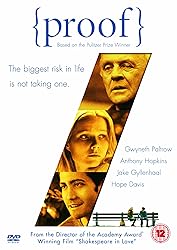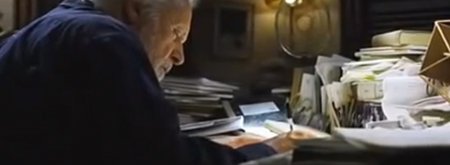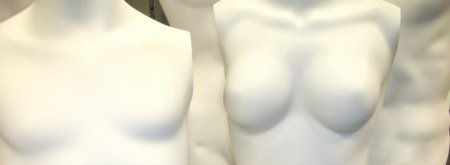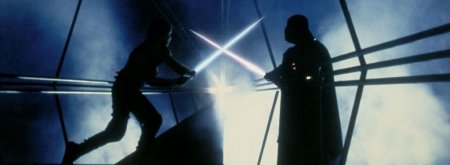Proof
How do we know who or what to trust? This is one of the key questions of the world we live in today. So many claims compete for our trust: whether it’s political parties clamouring for votes, computer companies telling you their new gadget is ‘magical and revolutionary’,[1] or the plethora of religions claiming to know the truth. Every day we must make decisions about who or what to trust. How do we decide what is really trustworthy? Through its characters, Proof explores some of the different approaches that can be taken in response to this question.
Weighing the Evidence
Warning: this article contains some plot spoilers
There are four main characters in Proof: Robert (Anthony Hopkins), a genius mathematician who declined into insanity in his late 20s; his daughters Catherine (Gwyneth Paltrow) and Claire (Hope Davis); and Harold ‘Hal’ Dobbs (Jake Gyllenhaal), a former student of Robert's who now teaches at a university. The story begins a week after Robert’s death. Catherine has spent the last five years caring for him, even leaving university to be with him. In contrast, Claire moved away to another city, played little part in caring for him and only returns for Robert’s funeral. Hal admired Robert a great deal, and decides to trawl through the hundreds of notebooks he filled during his illness to see if there is any publishable work in them.
As the film opens, Hal is at Robert and Catherine’s house, searching the notebooks. Catherine grows suspicious that he is stealing things to publish under his own name, and hastily calls the police. However, Hal had actually found a section of coherent writing saying how much Robert appreciated Catherine’s care for him. Hal was going to wrap it as a birthday gift for her. After this, Hal and Catherine grow closer, and she decides to show him a notebook hidden away in a draw. The notebook contains what appears to be a revolutionary mathematical proof. Hal and Claire are shocked – everyone thought Robert hadn’t been able to work for years. As the excitement grows, Catherine makes a confession: ‘I didn’t find it, I wrote it.’ This shocking claim becomes the central challenge for the remainder of the film. Who wrote the proof? Is Catherine lying? The characters’ responses reveal different ways of assessing what is true and trustworthy.
Claire’s approach is the most blatant; she is an absolute sceptic. She doubts almost everything Catherine says, and acts as though nothing she says can be trusted. This is seen early on in the film, when Claire mentions that some policemen had come over asking if Catherine was OK after the night before. Catherine says she called them ‘to get this guy to leave’. Claire looks doubtful and asks her, ‘What is this man’s name? Because the police said that you were the only one there.’ Catherine replies that his name is Harold Dobbs, but it is clear that Claire doesn’t believe her at all – she keeps questioning Catherine, using a sarcastic tone, implicitly stating that she thinks he is imaginary. Catherine is understandably annoyed by this, and in frustration shouts, ‘Harold Dobbs exists!’ Claire replies, ‘I’m sure he does ...’ but she is obviously unconvinced. This attitude becomes even clearer when Catherine claims to have written the proof: ‘So you wrote this incredible thing, but didn’t tell anyone? I’m sorry, but I just find that very hard to believe.’ She goes on to assert that, ‘It’s Dad’s handwriting ... it looks exactly like it’, despite Catherine’s insistence that it’s hers.
Claire requires such a high standard of proof that it is impossible for Catherine to satisfy her. At one point she suggests that Catherine tells them the proof, saying, ‘That would show that it was yours.’ Catherine agrees and takes the notebook, but Claire insists that she has to do it from memory. This is a hugely unfair demand, as Catherine points out: ‘I didn’t memorise it, it’s not a muffin recipe! It’s 40 pages long!’ Later, Claire asks her, ‘Is it possible that you just wanted it so badly, that you imagined you wrote it?’ Claire’s scepticism and mistrust of Catherine even goes as far as to accuse her of wishful thinking and self-delusion.
Hal’s approach to truth-claims is more subtle – he always wants more information before he makes a decision. This is clear when Catherine first claims the proof is hers. Catherine asks him to verify that the handwriting is hers, but he makes excuses, saying, ‘I’m not a handwriting expert’, and, ‘I don’t really know what Catherine’s writing looks like.’ Catherine is frustrated by his indecision: ‘You know there’s nothing even remotely like that [in the other notebooks]’ she protests. For Hal, even if Catherine could explain the proof, ‘it still wouldn’t prove that [you] wrote it ... your dad could have written it and explained it to you later.’ He insists that he’s ‘not saying that you didn’t write it, but there’s no proof that you did’. ‘Of course not!’ Catherine argues, ‘But he couldn’t have written it – even in the year he was well he couldn’t work. You know that!’ Even though the evidence is all against Robert having written the proof, Hal needs even more before he is willing to believe that Catherine wrote it. The roots of Hal’s hesitance can found in his emotions: he is afraid that Catherine’s achievement would belittle his own research and make him seem insignificant. Catherine picks up on this, bitterly remarking that if she wrote it, ‘it would be a real disaster for you.’
Hal’s solution is to have it examined by his university colleagues: ‘then we’ll have a lot more information.’ He nervously protests that, ‘I’m trying to determine what this is’, and is met with Catherine’s sharp reply, ‘I’m telling you what this is!’ It seems that Hal would like to believe Catherine, but he needs to be utterly convinced that something is true before he puts his trust in it. Later, when his colleagues have looked at the proof, Hal returns declaring his confidence that Catherine wrote it. He says that the maths techniques used were too recent to have been mastered by Robert, and points out that ‘even the most incoherent’ sections of Robert’s writing had a date on it, whereas nothing in the proof is dated at all. Nor is the handwriting an obstacle anymore as ‘parents and children sometimes have similar handwriting, especially if they’ve spent a lot of time together’.
how much evidence is it reasonable to demand before we trust something?
Catherine is unimpressed with this sudden change: ‘It’s what I told you last week! ... Now you’re certain? You don’t know anything! The book, the math, the dates, the writing – it’s just evidence. It doesn’t prove anything!’ Hal is shocked by this outburst and asks, ‘What would prove it then?’ Catherine’s reply is cutting: ‘Nothing. You should have trusted me.’
Hal and Claire’s approaches are similar, in that they both require huge amounts of evidence before they will trust Catherine’s claim, but they also differ greatly. Claire has already decided that Catherine is either lying or deluding herself – her demands for evidence are simply an attempt to reinforce her existing opinion. In contrast, Hal wants to believe Catherine, but his feelings hold him back from trusting what she says. His search for more evidence is an attempt to put off making a decision. Together, these two characters ask this question of the viewer: how much evidence is it reasonable to demand before we trust something?
Robert’s situation is the most unusual of the four, as we only see what he was like through flashbacks to the last few years of his life. Through these we see a man who thinks that he is grasping the truth, but who is actually making no sense at all. His illness deceives him, putting him under the impression that he is making progress. At his funeral, Catherine tells the shocked mourners that he would write for ‘19 to 20 hours each day ... convinced that he was writing the most beautiful, elegant proofs’. He filled hundreds of notebooks with nonsensical ramblings, but to him it seemed as though he was doing important work. Through no fault of his own, Robert was unable to discern the truth; his mental state prevents him from seeing things the way they really are. Perhaps Robert’s situation on some level reflects those worldviews which prevent us from understanding what is really true and trustworthy. Some ideas and ways of viewing the world can blind us to the way the world really is; they distort our thinking rather than clarify it. This is not to say that people with such worldviews are mentally ill as Robert was, but this position of being unaware that the truth is obscured by a deceptive mindset is in some ways comparable to Robert’s experience.
Catherine’s approach to truth-claims and trust is the most fragile of the four: she knows that the proof is hers, but in the face of scepticism her trust in that knowledge crumbles. Under pressure from Claire, and to a lesser extent from Hal, she begins to lose confidence in what she knows to be true. Despite the fact the she is obviously the author of the proof, her certainty is shaken to the core. At one point she breaks down under Claire’s pressure, sobbing, ‘it’s not mine; it’s his. I stole it from him.’ Towards the end of the film she even argues against the evidence Hal has gathered in favour of it being her work. Soon after, she describes how she feels:
I'm outside a house trying to find my way in, but it’s locked ... and I've lost the key. I can't remember what the rooms look like or where I put anything. If I dare go inside I wonder, will I ever be able to find my way out?
Under fire from those around her, Catherine’s confidence in the truth crumbles and she ends up on the brink of despair, not knowing whether anything she thinks can be trusted.
we must make decisions based on the available evidence
Proof shows us four different approaches to truth-claims, but in reality very few of us will exactly mirror just one of these characters; it is more likely that our thinking contains elements of all of them. Some of us may even move through different ways of thinking in the course of our lives. Proof offers a fascinating insight into the issue of trust, but the conclusion it seems to point to is that none of these approaches are entirely satisfactory. But if our approaches to truth are all ultimately unsatisfactory, we need someone who is unhindered by an imperfect worldview to reveal the truth to us. The Bible tells us that Jesus is that person: he didn’t just know the truth; he claimed ‘I am ... the truth’ (John 14:6).
The truth-claims made by Jesus provoked far stronger opposition than that faced by Catherine; his family thought he was ‘out of his mind’ (Mark 3:21) and the religious teachers of his day accused him of blasphemy (eg. Mark 2:7). At one point his teaching was so challenging that many of his followers ‘turned away and deserted him’ (John 6:66). His words and deeds are just as controversial today; and yet Jesus asked people to ‘trust in God, and trust also in me’ (John 14:1) How do we know that we can trust Jesus? His first followers were also unsure whether he was who he claimed to be, but they became convinced it was true when he rose from the dead. Paul, one of the early church leaders, wrote that Jesus was, ‘shown to be the Son of God when he was raised from the dead ... he is Jesus Christ our Lord’ (Romans 1:4). Of course, in today’s world this is hard for us to believe: but before we dismiss such a claim we must ask ourselves, is there any evidence for it? As Catherine points out in Proof there are some things that cannot be proven beyond a doubt; we must make decisions based on the available evidence. The evidence for the resurrection of Jesus is there – how will you approach it?
 Film title: Proof
Film title: Proof
Keywords: Belief, trust, faith, evidence, proof, doubt, certainty
Director: John Madden
Screenplay: Rebecca Miller, based on the play by David Auburn
Starring: Gwyneth Paltrow, Anthony Hopkins, Jake Gyllenhaal, Hope Davis
Distributor: Miramax Films (USA); Walt Disney (UK)
Cinema Release Date: 2005
Certificate: PG-13 (USA); 12A (UK) Contains strong language and moderate sex
Buy Proof from Amazon.co.uk or from Amazon.com
Further Reading on the Resurrection
Articles
Josh McDowell, Is there really solid evidence for the resurrection of Jesus?
Alister McGrath, The Resurrection
Audio
Peter S. Williams, The Resurrection Puzzle
Reference
[1] Description of the original Apple iPad
© 2010 Tom Roberts



